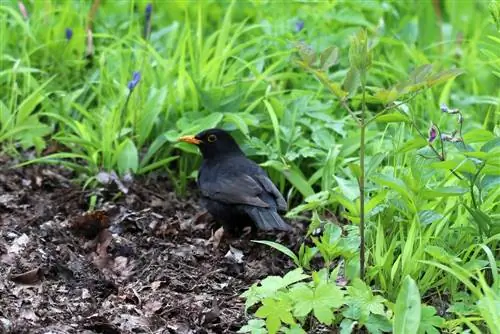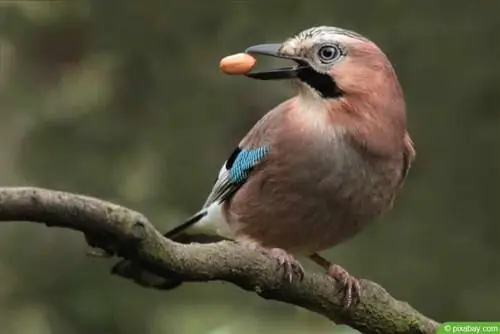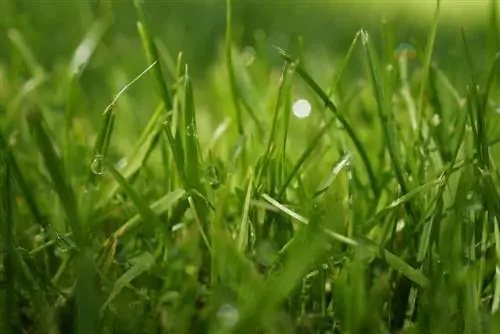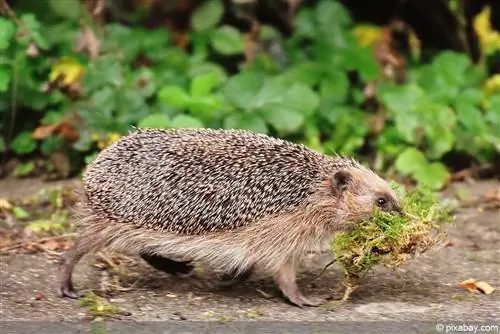- Author admin [email protected].
- Public 2023-12-17 03:39.
- Last modified 2025-01-24 12:45.
The blackbird has the scientific name Turdus merula. It is one of the most famous songbird species in Europe. A male blackbird is considered to be extremely creative in inventing his melodies in his territorial song. This is announced in the spring from an exposed location, such as a roof, fence post or tree. Because the male has the darkest plumage of all the thrush species, to which the blackbird belongs, it is sometimes also called the black thrush.
Profile
- scientific name: Turdus merula
- other names: Black Thrush
- belongs to the genus of thrushes within the order of passerines
- native songbird species
- Size: up to 27 cm
- Wingspan: up to 40 cm
- Plumage: Males black, females gray and brown tones
- Age: up to 6 years
- Weight: average 100 grams
Appearance and identifying features of the blackbird
Male blackbirds are very conspicuous due to their shiny black plumage and bright yellow to orange beak. They also have a beak-colored ring around their eyes. Occasionally you can also see a blackbird with white spots that are caused by a genetic defect. As a rule, the males are around 27 cm tall and are only slightly larger than the female birds.
The female's beak and eye ring are less colorful. Light yellow beaks are occasionally found here, but shades of brown are more common. Female blackbirds are much better camouflaged thanks to their brown plumage. The colors vary from dark brown to olive tones to slightly grayish and reddish brown. The chest area is mottled or striped in brown-gray to yellow-brown.
Food Sources

Blackbirds spend most of their time on the ground while searching for food. They are considered undemanding omnivores and feed on both meat and plant-based food. When raising young birds, most invertebrates are on the blackbird's menu:
- Earthworms
- Snails
- Beetle
- Spiders
- Centipede
Occasionally the predatory bird also preys on smaller lizards or snakes. The eggs or young birds of other bird species are also not safe from him. In the colder seasons, different berries and fruits are very popular. Because of the widely varying food supply and the way young birds are raised, the weight of a blackbird fluctuates greatly. In August, when the breeding season comes to an end, blackbirds reach their lowest weight of around 50-70 grams. In autumn, when the availability of animal and plant food is at its highest, they eat up their fat reserves, so that in January they weigh twice or three times as much, at around 150 g.
Food procurement
Blackbirds are known for their unique way of foraging. They can often be seen standing motionless on the lawn or under bushes with their heads tilted at a specific spot on the ground. Then suddenly they snap with a lightning-fast pecking movement and capture the prey with their beak. At times they also scratch around noisily in dry leaves or a compost heap to prey on worms or beetles.
breeding season
The breeding season for blackbirds begins in February to March. This makes songbirds early breeders. During a season, couples are mostly monogamous. Depending on their distribution area, blackbirds raise two to three broods per year. In warmer summers or areas they may breed until the end of August. The female blackbird usually does not wait until the last brood has left its parents to mate and lay eggs again. This phenomenon is called box brooding. The father of the new young birds does not necessarily have to be the one of the first brood. The father is often left alone with the young birds while the female blackbird incubates a new nest with a new partner.
Nesting site and brood care
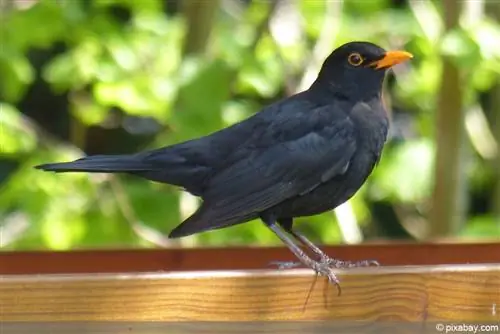
Blackbirds nest primarily in trees or bushes, and rarely on the ground. The typical nest height is around 1.5-2 meters. Between four and five eggs are laid there every 24 hours, and usually only two at the end of the breeding season. After incubation by the female, who only leaves her clutch to feed (feeding by the male is rare), the young birds hatch after an average of 13 days. The young birds leave the nest after just two to three weeks. However, at this point they are not yet able to fly and are therefore still fed by their parents on the ground. At the age of 7-8 weeks they are independent and leave their parents.
The right food in winter
Around 75% of the blackbird population stays with us over the winter. Blackbirds actually rely on at least small amounts of protein-containing food (insects) all year round. If this becomes scarce, they switch to berries remaining on trees and bushes, such as firethorn or ivy berries. Blackbirds generally do not need to be fed until January, as the food supply in nature is still quite plentiful. Blackbirds are soft food eaters. In contrast to the grain eaters, they cannot do anything with sunflower seeds. To maintain their body temperature in winter, blackbirds need either a lot of food or rich food. High fat contents provide a large amount of energy, so crushed grains soaked in fat are particularly suitable for feeding.
- Oatmeal
- Wheat flakes
- Bran
Fresh food is rich in vitamins, which blackbirds urgently need in the cold season. They like to eat fresh apples, but they also don't disdain fruit that is no longer completely fresh. Raisins are a particularly tasty and sugar-rich treat. Blackbirds prefer raisins to fresh apples.
Tip:
S alt-containing foods must not be fed. Bread is also not suitable as it spoils quickly and also swells in the bird's stomach.
The right feeding place
It is best to offer food to blackbirds close to the ground. Special floor feeders are available for this. Place the feeder where you can easily observe the birds. However, always remember that there should be trees or bushes at an appropriate distance so that the birds can find protection. Natural enemies of the blackbird are:
- Birds of prey such as sparrowhawks, peregrine falcons
- Squirrel
- Magpies
- Cats
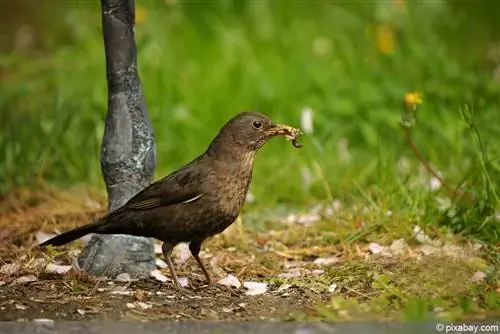
Ground feeding stations can also be easily built yourself. The food should not lie directly on the ground. It is better to place this on an old plate. An old wooden box serves as protection from the weather. Here, one long side and one short side are removed and the roof is instead supported with suitable sticks. This gives the birds the opportunity to fly away in two directions and the food is protected from wind and precipitation.
Tip:
Good hygiene is also important. The best feeders are those where the birds don't walk around in the food. Otherwise, the feeding area should be cleaned regularly with hot water.
What you should know about blackbirds in brief
- The blackbird is a semi-cave breeder. She must be able to observe her surroundings at all times.
- A suitable nesting box for a blackbird must therefore have a large opening at the front. However, they are easily accessible to robbers.
- That's why a new nesting box was developed: This now has two oval entry holes measuring approx. 32 x 50 mm.
- There are also nesting boxes that have a special extended stem. These boxes can therefore be hung freely.
- The half cave has an additional breeding chamber insert. Even on dark slopes, the entrance opening provides good light.
- Blackbirds often breed several times in a row. They keep building over the old nest. It continues to be increased.
- Contamination and parasite infestation can occur. You should remove the old nest immediately after breeding, before the blackbirds build a new one.
By the way:
Despite nesting boxes, blackbirds often simply nest in a hedge. They just like it when they have everything under control. You can help them there by postponing hedge trimming until after breeding. While the birds are breeding, leave the hedge as it is. Blackbirds like a birdbath that is large enough for them to take a bath in. Blackbirds love to bathe, especially when it is warm.

